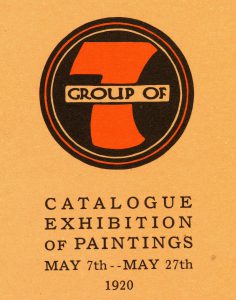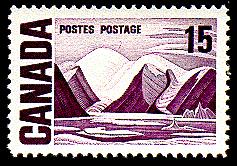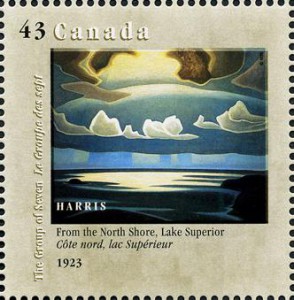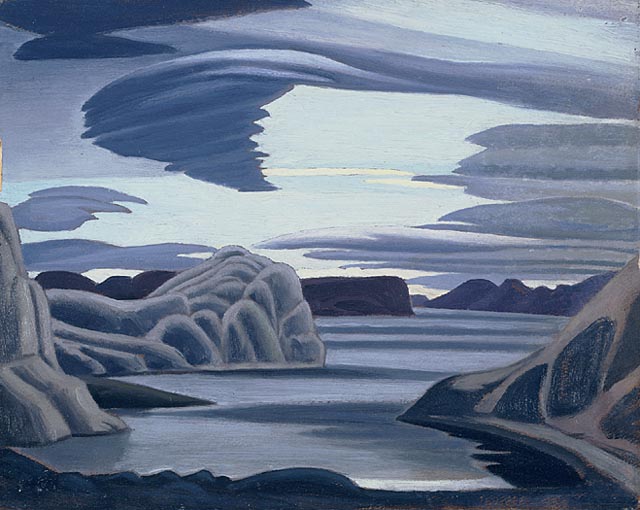On today’s date in 1981, Canadian artist Lawren Harris’ 1930 oil-on-beaverboard painting South Shore, Baffin Island sold for $240,000—then a record for a Canadian painting.
At the time, it was the most valuable painting to cross the auction block in Canada.
More recently, in 2001, South Shore, Baffin Island sold for a new record of $2.2 million.
Harris was born in Brantford, Ont., on Oct. 23, 1885. Forty-five years later, in May 1920, Harris and six other Canadian landscape painters later known as the Group of Seven – Canada’s best-known school of art – held their first exhibition.

The catalogue for the Group of Seven’s first exhibition, which opened on May 7, 1920, explained the artists’ belief that ‘art must grow and flower in the land before the country will be a real home for its people.’ Photo via the E.P. Taylor Library and Archives, Art Gallery of Ontario.
“The group of seven artists whose pictures are here exhibited have for several years held a like vision concerning Art in Canada,” reads the 1920 exhibition catalogue. “They are all imbued with the idea that an Art must grow and flower in the land before the country will be a real home for its people.”
Held at the Art Gallery of Toronto (now the Art Gallery of Ontario, or AGO), the art show attracted more than 2,000 visitors during its 20-day run; however, of the more than 120 paintings on display, only a handful of pieces were sold.

A 15-cent stamp commemorating another Harris painting – Bylot Island – was issued by Canada’s Post Office Department in 1969.
The headline of a review published in Toronto’s Daily Star newspaper read, “Seven Painters Show Some Excellent Work,” which reflected “the moderate opinion of most critics,” according to a statement from the McMichael Canadian Art Collection.
Another 1920 story review by The Canadian Courier asked, “Are these new Canadian painters crazy?”
After the Group of Seven’s first exhibition opened, Jackson wrote a letter to his mother stating the event was “attracting quite a lot of attention even if it is not understood.”
Sometimes referred to as “the hot mush school” in the group’s early years, the painters’ work eventually earned the respect of art critics for painting Canada “as nobody had ever thought of painting it before,” according to the National Gallery of Canada, which unveiled two of the seven stamps on May 6, a day before they were issued.
“The wild colours of a Canadian autumn; the solitary lakes of northland; the monolithic islands of Lake Superior; the glacier-tortured landscape of the Laurentian Shield; the grim exhaustion of a hillside emerging from four months of winter snow – this was Canada as it is, a land like none other, and Canadians abruptly recognized it as their own.”
The group’s final show – also held at the AGO – opened in December 1931.

Canada Post commemorated another Harris painting, From the North Shore, Lake Superior, on a 43-cent stamp in 1995.
Harris died in Vancouver on Jan. 29, 1970, and his ashes were buried on the grounds of the McMichael Canadian Art Collection.
HARRIS STAMPS
In 1969, Canada’s Post Office Department (known as Canada Post since 1981) commemorated another Harris painting, Bylot Island, on a 15-cent stamp (Scott #463).
Printed by the Canadian Bank Note Company (CBNC), the dull purple stamp has 12 perforations and Winnipeg two-bar tagging.
In 1995, Canada Post once again commemorated Harris’ work – this time a painting called From the North Shore, Lake Superior – on a 43-cent stamp (SC #1559).
Also printed by the CBNC on fluorescent coated paper, which was used instead of tagging, the stamp has 13.5 perforations.
In 2020, Canada Post once again commemorated the Group of Seven with seven stamps, one of which featured Harris’ circa 1925 painting, Miners’ Houses, Glace Bay.

